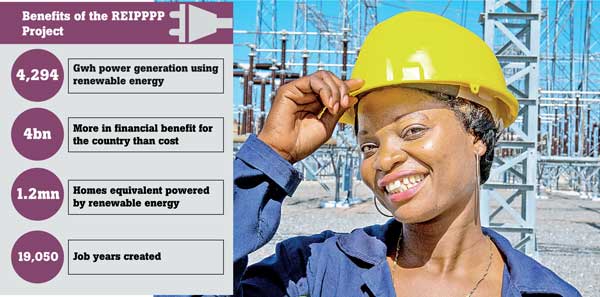30 Nov 2016 - {{hitsCtrl.values.hits}}

The successful delivery of basic infrastructure through private-public partnerships (PPPs) has helped eliminate extreme poverty and has boosted shared prosperity. According to the World Bank’s Private Participation in Infrastructure Database, over the past five years, the private sector has invested an average of US $ 124 million per year in infrastructure projects.
Sri Lanka has much to learn from international success stories, when implementing PPPs. One such example is the Renewable Energy Independent Power Producer Procurement Plan (REIPPPP) in South Africa.
The South African National Planning Commission through the national development plan identified the critical need to invest in energy infrastructure, in order to facilitate an added capacity of 10,000 MWs in the country by 2025.
The government initially sought to meet this requirements through feed-in-tariffs (FITs) – which are payments made to households for generating their own green energy – however, this was later rejected in favour of competitive bids from private entities. The facilitation of competitive bids led to the creation of the Independent Power Producer Procurement Programme (IPPPP), which was designed as a key mechanism for securing electricity capacity from the private sector for renewable and non-renewable energy sources. The REIPPPP called for request for proposals from the private sector and five bidding windows were opened. As a result, a total capacity of 6,327 MWs was secured.
The first three bidding windows were a noteworthy success, having attracted a wide variety of domestic and international project developers, sponsors and equity shareholders.
By June 2015, the REIPPPP had connected 37 IPPs to the grid and transformed the South African energy landscape for the better.
Two key enabling factors led to the creation of a successful PPP. These include:
Programme management factors:
One of the key elements which led to the success of the REIPPP was the ad hoc institutional status of the Energy Department’s, Independent Power Produced unit. This establishment has a keen focus on problem-solving, quality and transparency and not merely on administrative arrangements.
Furthermore, the management team and the team leader had extensive experience, PPP expertise and credibility among the public and private stakeholders. This credibility helped overcome the mistrust by the private sector, which previously restricted public-private dialogue.
Programme design factors:
The size and structure of the bidding process, which resulted in multiple bid winners, were an important incentive for private sector participation. This in turn was a quick and efficient way for rolling out new generating capacity.
The opportunity for developers to make a reasonable profit due to tariff caps in round one was an added incentive for private sector participants. The subsequent shift to competitive bidding during the next rounds helped tariffs to come down further.
The requirement for bids to be fully underwritten with debt as well as equity eliminated the tendency of competitive tenders to incentivize underbidding to win contracts.
It is vital for Sri Lanka to take from these international success stories, the strategic decisions and good practices, which led to the success of the project. Especially the transparent bidding process, with multiple bid winners encouraged private sector participation coupled with the foresight of an experienced programme management team.
(This column is part of the ‘PPP Knowledge Week’ initiative by the Ceylon Chamber of Commerce in collaboration with the World Bank, in support of the World Bank’s roundtable discussion on Country Readiness for PPPs and Way Forward, which will be held on December 2, 2016)
25 Nov 2024 2 hours ago
25 Nov 2024 3 hours ago
25 Nov 2024 3 hours ago
25 Nov 2024 5 hours ago
25 Nov 2024 5 hours ago